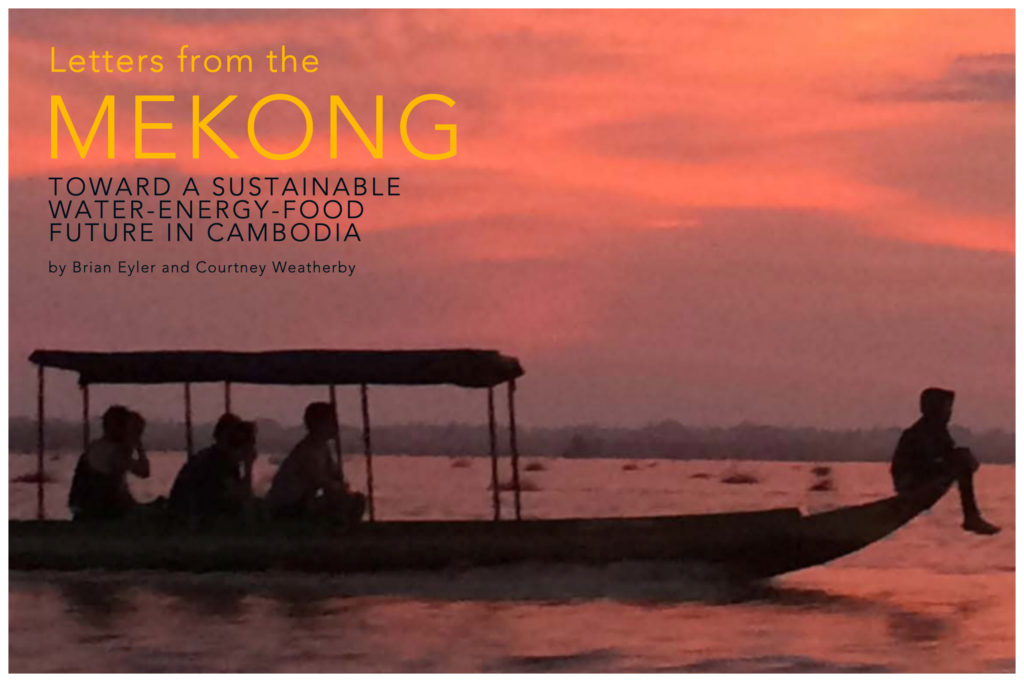Stimson’s Southeast Asia Program is pleased to share the fifth issue brief in Stimson’s Letters from the Mekong series, which explores the vital role that Cambodia’s Tonle Sap Lake plays in the Mekong and identifies alternative pathways for development which can optimize trade-offs to the water-energy-food nexus. These alternative approaches include basinwide water-energy planning and a deeper incorporation of non-hydropower renewable energy sources into Cambodia’s future power mix. If utilized, these alternative pathways can avoid upstream fragmentation of Tonle Sap and Mekong Basin connectivity and preserve the annual monsoon pulse, which underpins the unique conditions that make the Tonle Sap the world’s largest freshwater fishery.
Each year, the entire Mekong Basin produces a 2.6 million tons freshwater fish catch that supports the diets and livelihoods of more than 60 million people living in the basin. To put this into perspective, the total catch from wild fisheries in all of North America’s lakes and rivers is only 450,000 tons. The Tonle Sap Lake alone provides an annual freshwater fish catch of around 500,000 tons, which provides Cambodians with 75% of their protein intake. Hundreds of species of fish spend a portion of their lives in the Tonle Sap and then migrate to other parts of the Mekong River system in Laos, Thailand, and Vietnam where some are caught and contribute to the Mekong’s overall fish catch.
The annual flooding and draining of the Tonle Sap Lake acts as the natural engine orheartbeat that pumps life throughout the Mekong Basin. This heartbeat is threatened by the ongoing construction of and future plans for hydropower and irrigation dams upstream of the Tonle Sap in Cambodia, Laos, Vietnam, and China. Dams and other built structures block or reduce flows in the Mekong, which reduces the amount of water, fish, and nutrients going into the Tonle Sap each year and also constricts the ability of fish to find upstream habitats. In Cambodia alone, the connectivity of the country’s 11,000 kilometers of the Mekong/Tonle Sap river system has already been reduced by 31% by the construction of two hydropower dams and six irrigation reservoirs. The improper siting of dams on Cambodia’s tributaries would reduce connectivity by more than 60%, and mainstream dams at Sambor and Stung Treng would cut the Tonle Sap’s connection to most of the Mekong River system.
Cambodia needs to develop energy projects to meet rising electricity demand and drive economic growth. Hydropower will and should play an important role in Cambodia’s future energy mix, but system-scale planning methods can be used to site and operate Cambodia’s future dams in ways that have minimal to no impacts on Tonle Sap connectivity. Hydropower dams can also be sited and operated in ways to pair with intermittent sources of renewable energy such as solar, wind, and biomass that would lead to a more diverse and resilient energy system.
This report introduces system-scale planning methods, provides policy recommendations, and identifies research opportunities which policymakers and other stakeholders in Cambodia can use to develop a more sustainable water-energy-food future for the Tonle Sap Lake and the Mekong basin at large. It also identifies specific ways in which development partners and investors can engage with stakeholders in Cambodia to develop water and energy resources in ways that more sustainably meet Cambodia’s economic development goals.
Download the report. If you’re interested in a discussion with the authors, watch the livestream from the report launch.

